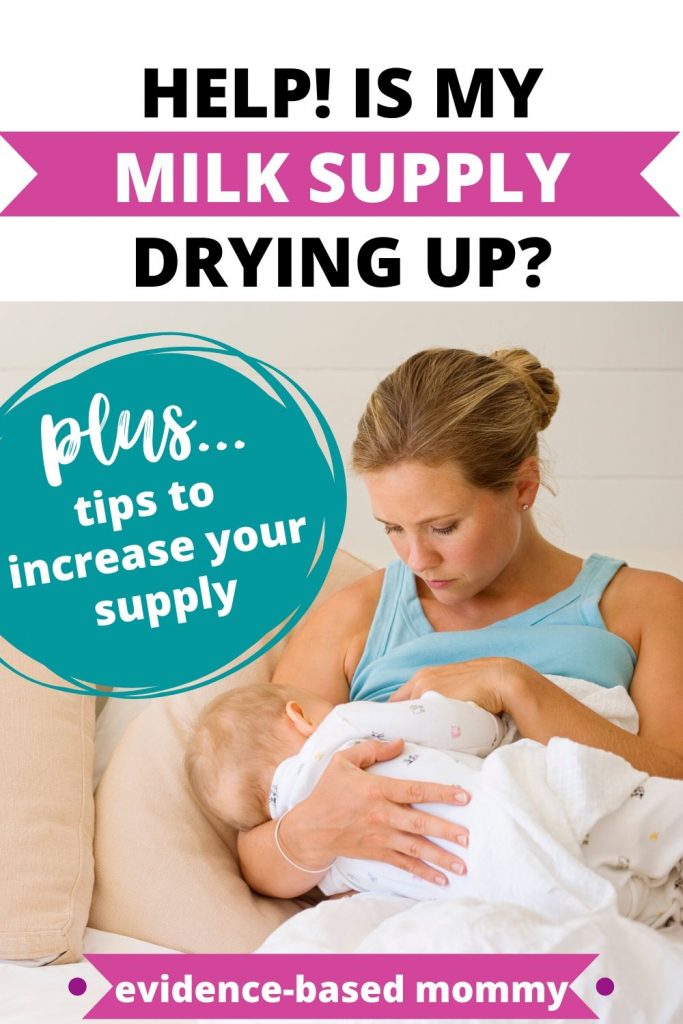Maybe you’re still in the new phase of breastfeeding. Your baby is latching, things are going well… but then suddenly something doesn’t seem right. You’re worried: How do you tell if your milk is drying up?
Disclosure: This article contains affiliate links. As am Amazon associate I earn from qualifying purchases. You can read my full policy here.
If you’ve been really excited about breastfeeding, it can be devastating to think that it might not work out. You want answers, fast, wondering, Is my milk drying up so soon?

I know how scary it is to think your milk supply is in jeopardy. Read on to find out whether you have symptoms of your breast milk drying up. This post will tell you how to tell if your supply is drying up, and what you can do to help if it is.
Table of Contents
Milk drying up or growth spurt?
Does this sound familiar?
When your baby was born, you had colostrum, the thick, golden precursor to mature breastmilk. You managed to get your baby latched and you were so proud of yourself. You felt like a total badass.
RELATED: Newborn breastfeeding – 12 tips

A few days later, your boobs got huge and rock hard. And it hurt. Your milk was coming in, and your breasts were engorged. But you kept nursing and powered through.
RELATED: Engorgement relief for the first week breastfeeding
After a few days, thank goodness, your breasts settled down. They’re still a bit bigger than they were before, but they aren’t painful and other than having to smack your partner’s hands away from them, they’re not causing too much trouble.
But around 3 weeks in, something changes. Your baby is fussy. She’s nursing constantly. She’s not sleeping well.
And you’re having trouble too. You can’t even go 2 hours without your baby begging to eat, and you’re exhausted. On top of that, your breasts have gotten softer. Has your milk dried up at 3 weeks?!
RELATED: How to know if my breastfed baby is eating enough
Now you’re worried. Dear Aunt Sally suggests topping your baby off with formula, just to make sure she’s not hungry, but you’re heartbroken. You really wanted to make breastfeeding work.
What’s happening?
Signs of a growth spurt
Believe it or not, everything you’re experiencing is likely perfectly normal. What may seem like symptoms of your milk drying up is probably your baby going through her first growth spurt.
During a growth spurt, your baby will eat much more often than usual. She’ll likely be more fussy and not sleep as well. This is called cluster feeding.
RELATED: Surviving night time cluster feeding
At the same time, your body is adjusting to the amount of milk she needs. While you were overproducing at the beginning (hence the engorgement), you’re now making the “correct” amount. You’re less full of milk, so your breasts are softer. This is a good thing!
You don’t have to worry that you’re running out of milk. As my lactation consultant friend says, “Breasts aren’t a bucket, they’re a river. There’s always some milk in there.”
Just wait out the situation for a few days. Your baby will be fussy and eat constantly for two or three days, and a day or so later she’ll sleep extra. That’s a good indication that the growth spurt is over.
And after that, you might end up with some engorgement again! Your breasts were working overtime to keep up with the growth spurt, but once your baby’s demands go back to normal, your breasts naturally cut back on the amount of milk they make.
While it can vary a little, growth spurts usually happen at 3 weeks, 6 weeks, 9 weeks, 3 months, 6 months, and 12 months. If your baby was born a few weeks early, these time frames might shift to reflect her “due date age.”
The first few growth spurts at 3 weeks and 6 weeks can be confusing, especially for first-time moms. The combination of increased demand with softer breasts can be worrisome if you don’t know what to expect!
Other reasons for a brief drop in supply
There’s a few more reasons you may see a dip in supply that will come back in a few days. So if you’re freaking out, wondering, “How do I know if my milk is drying up?” we’ve got you covered. Most likely, you’re fine.
Your period is about to start
Is your cycle about to start? Your supply is likely to dip a few days before your period, but it bumps back up once you start (And yes, this supply dip can happen before that first period that you don’t know is coming).
RELATED: Milk supply drops during your period? Try this
You’ve taken cold medicine
Have you taken an antihistamine or nasal decongestant? These drugs can decrease supply (NOTE: Be careful to avoid antihistamines or nasal decongestants in the future, as taking them too frequently can permanently drop your supply).
You’re pregnant
Repeat after me: Breastfeeding is not a 100% effective form of birth control. Breastfeeding is a 98% effective form of birth control for the first six months IF your period hasn’t returned and IF you are feeding every 3-4 hours during the day and every 4-6 hours at night. Trust me, I got pregnant while breastfeeding 3 times.
Sometime around the end of your first trimester, your supply will begin to dwindle.
These are NOT symptoms that your milk supply is drying up
Here are symptoms that women commonly fear mean a decrease in supply. If these things are happening, they aren’t signs that your milk is drying up.
Softening breasts
Softening breasts simply means that your body is adjusting to the correct amount to feed your baby. They do NOT mean that something is wrong with your supply.
In addition, you can also have a perfectly fine supply without leaky breasts. Mine leak for the first few months, but after that, I rarely have leaking.
Fussy baby
Especially during growth spurts (or the dreaded purple crying phase from 6-12 weeks), sometimes babies just cry. It doesn’t mean you’ve done something wrong.
RELATED: Purple crying – when you can’t make your baby stop crying
Poor pump output
If you’re worried about supply, you might try to pump milk to make sure there’s some in there. But when you pump, you don’t get much out!
Just because you don’t get a lot of milk when pumping isn’t a sign that you’re “drying up.” Many women don’t respond well to breast pumps and simply release less milk for a pump than for their child.
Good signs that your milk supply is NOT drying up
If your baby’s diaper output is still good (4-5 well soaked wet diapers per day), your milk supply is probably fine (NOTE: After 4-6 weeks, many babies stop pooping daily. This is normal).
If you’re really concerned, you can go for a weight check with a lactation consultant before/after a feeding. Since there aren’t lines on a breast to let you know how much milk your baby took in, weighing before and after a feeding is a good way to prove to yourself that she actually ate (home scales aren’t accurate enough to check this measurement; that’s why I recommend going to a professional).
Your pediatrician can also check your baby’s blood glucose levels to make sure she’s eating enough.
What to do to boost milk supply
On the other hand, there’s several ways you can help if you’re afraid your breast milk is drying up. Check them out below:
Get some breastfeeding education
When I was pregnant with my first baby, my friend bought me The Womanly Art of Breastfeeding. I cannot tell you how helpful this book was for me. I read it cover to cover (that’s just the kind of girl I am) a month or so before my daughter was born.
Knowing what to expect was really empowering. Whenever a growth spurt happened, I didn’t worry, because I had read about it beforehand.
Now, you can find online breastfeeding classes like Milkology. The video component of this course lets you see exactly what a good latch looks like and what to expect while breastfeeding.
RELATED: Milkology’s The Ultimate Breastfeeding Class review (by an experienced breastfeeder)
Whether you’re more of an online course person or a book person, you can’t go wrong with either of these resources.
Breastfeed on demand
Don’t worry about a clock. If your baby is showing hunger cues, go ahead and feed her. In fact, you can even offer when your baby isn’t acting super hungry. She won’t nurse if she doesn’t feel like it!
Frequent nursing tells your breasts to make more milk, so the more you nurse, the better your supply will be.
And don’t be afraid to breastfeed at night. I know there’s a prevailing myth that babies are “supposed” to sleep through the night by a certain age, but there’s nothing wrong with them nursing at night time. Make sure your baby is in your room with you (preferably in a bassinet close beside you) to make night feedings easier.
In addition, don’t worry about nursing sessions lasting a certain amount of time. Some babies (especially very young ones) nurse for a long time, while others are efficient little milk monsters and get done eating in 10 minutes. Either way is fine.
Try skin to skin
Skin-to-skin contact with your baby encourages production of oxytocin, the bonding, mothering hormone. This in turn helps with the milk ejection reflex (or “let-down”) so that you release milk.

Take as much time as you can to cuddle up in bed (if you’re on the sofa, be sure not to fall asleep) with you shirtless and baby down to a diaper. You can hang out and watch a movie, read a book, do whatever while your baby dozes and nurses. It’s a really nice way to bond and help your milk production!
Even if you aren’t in a situation where you can take off your clothes with baby, contact is still helpful. There’s a lot of benefits of cuddling your baby in a carrier, and increased milk supply is one of them! So put your little one in a sling and go for a walk.
RELATED: Best baby carriers
Use breast compressions
Compressing your breasts while nursing can help drain them better. Not only will your baby get a little extra food, but you’ll signal your breasts to make more milk next time.
When you do breast compressions, hold your hand in a C shape and press back on your chest while also using your fingers to press milk towards your nipple (don’t just squish your boob). This video does a really good job of showing how to do it.
Breast compressions make a big difference in boosting supply! When I pumped at work for my first daughter, I had a really large output because I used compressions to get out as much milk as possible. But then, my supply was so robust that it seemed like I was drowning her over the weekend!
Use a pump to work with the other breast
If your supply truly is low (instead of just a growth spurt), you can pump the other breast while feeding. Not only will that stimulate more milk production, but you’ll have a little breast milk for a top off if it makes you feel better.

Have you ever heard of the Haaka? It’s a silicone breastmilk collector and is great for this exact use.
You squeeze the base right before putting it over your nipple. The suction allows it to stay in place, and you’ll collect any leaking milk. Genius!
If you only slightly squeeze it, you’ll just get whatever drops of milk that leak as you nurse from the other side. But if you compress the the bulb more before attaching it, the extra vacuum created will pull more milk out. That way, you can “pump” while primarily focusing on your baby.
Honestly, I prefer the Lansinoh breastmilk collector over the Haaka. It comes with a lanyard so you can strap the collector around your neck. That way, if you aren’t holding the collector and it drops because the suction breaks, you won’t lose all that milk you just expressed.
Check your pumping schedule
If you are back to work and pumping, make sure you pump as often as your baby would nurse if you were together (usually, that means every threeish hours).
I have found that if I try to compress two nursing sessions per day into one big session, my supply dips by the end of the workweek. Pumping twice a day (or however many times it takes to get to once every 3 hours) will bring it back up within a few days.
What NOT to do if you’re worried that your milk is drying up
These common pieces of advice can actually do more harm than good.
Top off with formula
I get the temptation to “top off” your baby. But here’s the problem:
Breastfeeding is based on a supply and demand system. The more your baby suckles, the more prolactin is released, causing you to produce more milk for future feeds.
If you give your baby extra formula, you’re making it less likely for her to ask to nurse later. Your baby feeds less, causing you to produce less milk. It’s a downward spiral (although frequent feeding can often boost supply back up if you’ve started this process).
Check with your lactation consultant to determine if your baby truly needs supplementation.
Introduce solids
Some pediatricians will suggest you start offering rice cereal to help keep your baby full (Side note: Pediatricians often have little training in lactation). But the gut is not ready for solids until around 6 months old, when your baby can sit up independently.
Give up
If breastfeeding is something you really want to do, then don’t give up as soon as something worries you. Often, breastfeeding problems that look like big emergencies will resolve themselves in a day or two.
At the same time, only you and your baby can know if breastfeeding is right for you. No one can force you to continue trying if it’s honestly not something you want to do. Whichever decision you make, it will be okay.
RELATED: Advantages of breastfeeding
RELATED: Benefits of breastfeeding by age
Conclusions on if your milk is drying up
I hope you found this post reassuring. Most likely, your supply is not drying up; there’s just something else going on. If you’re still worried, you can always check with your lactation consultant or local La Leche League leader.
Remember, you’re doing great, Mama. Enjoy that baby.


Thank you sooo much! I was freaking out because my baby was eating all the time.
Glad to help!
Thank you so much! I’ve been super stressed about my supply because my daughter is nursing constantly, but maybe it’s just because she’s 6 weeks?
That’s probably it – the 6 week growth spurt! She’ll be back to “normal” in a few days. Good luck!